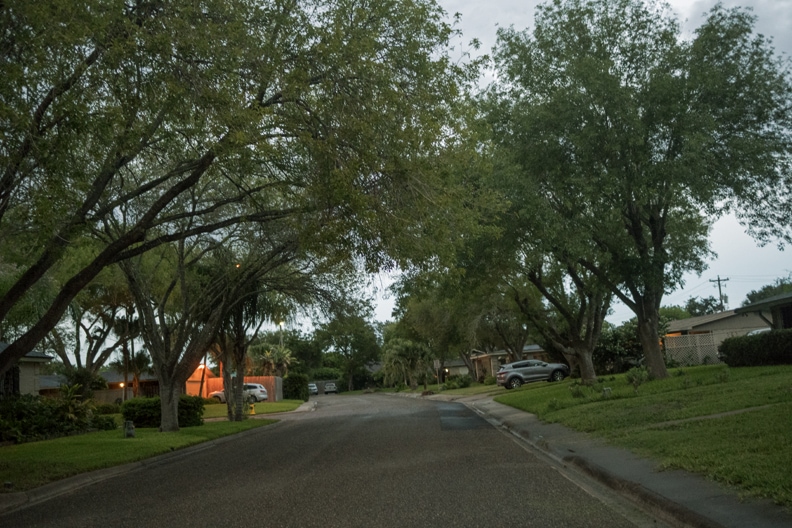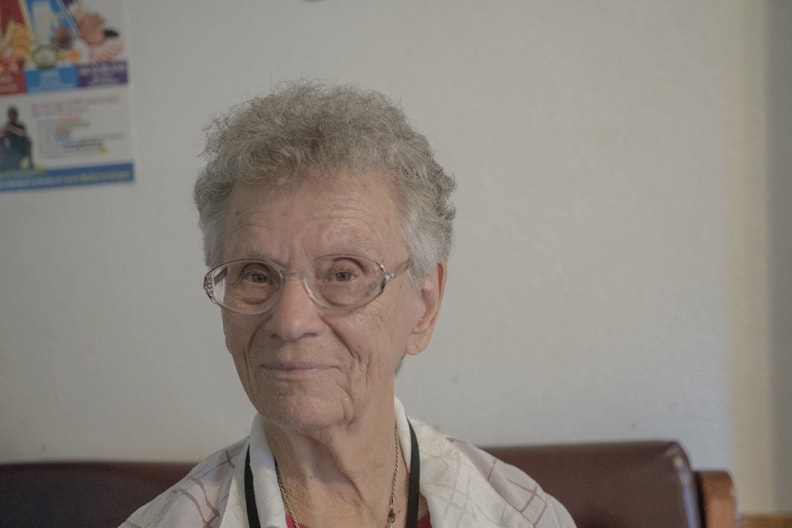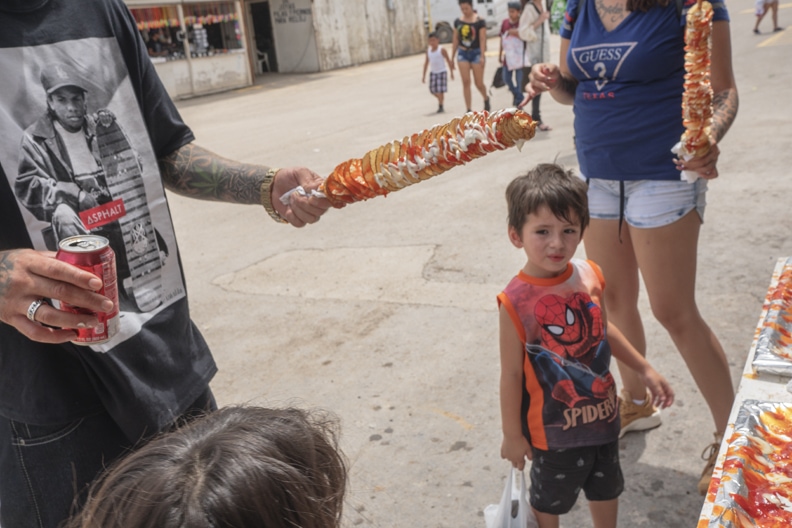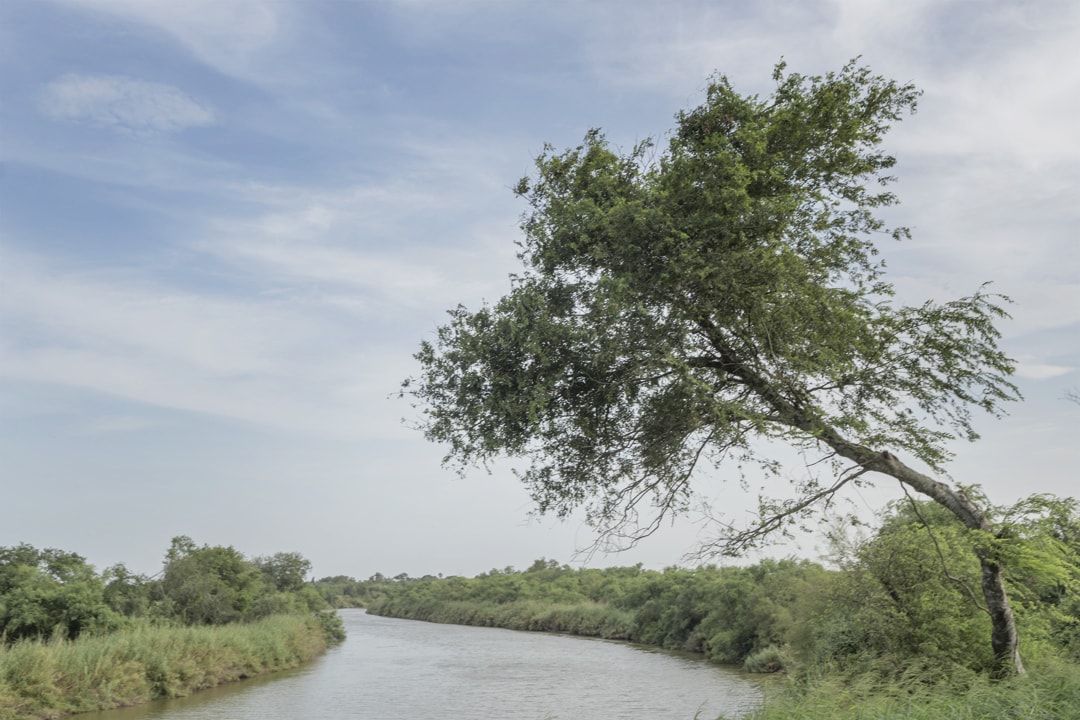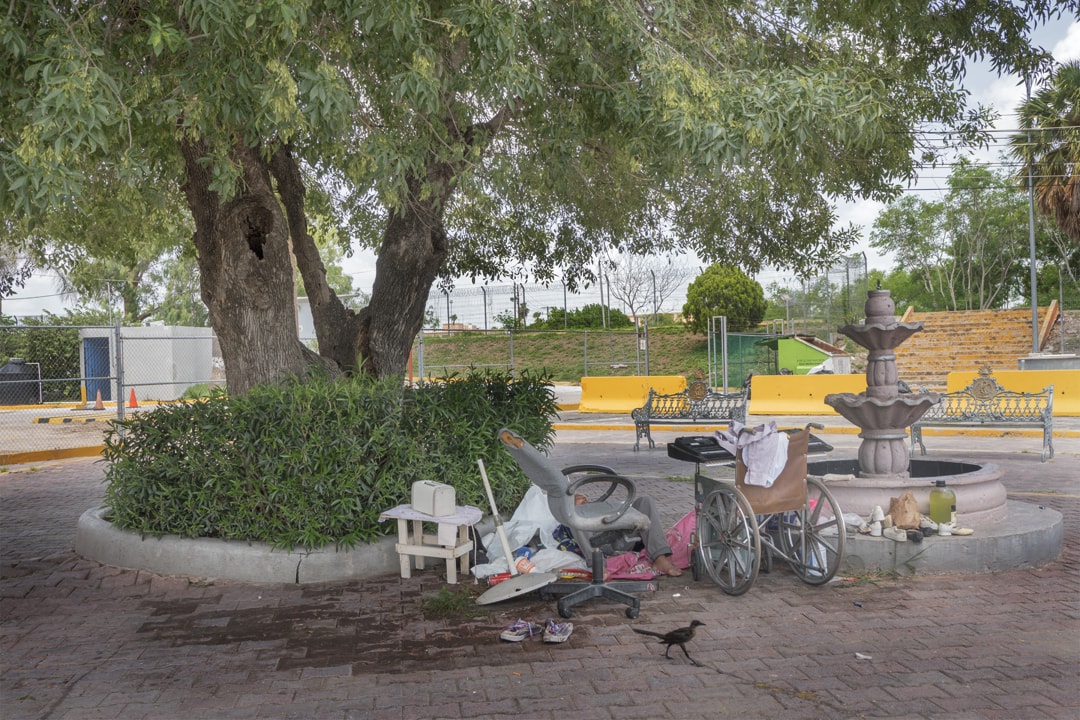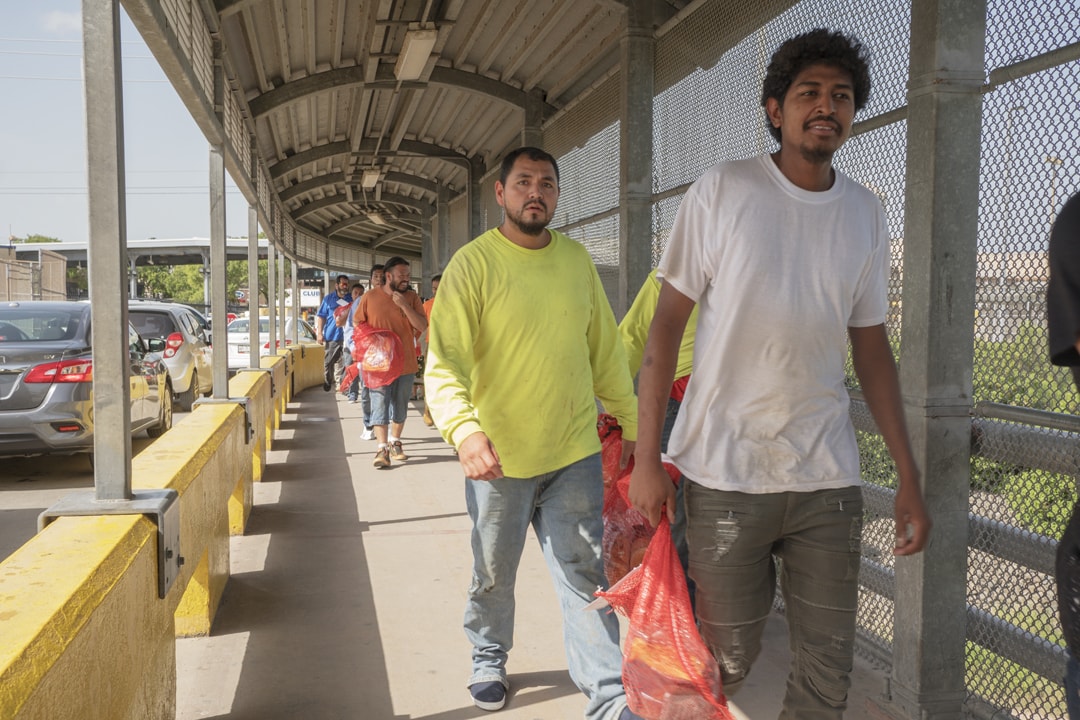In July, 2018, I went to Brownsville Texas, on the U.S.-Mexico border, with two friends.
That spring had seen the implementation of the Trump administration’s “zero tolerance” policy on immigration. We’d heard about children taken from their mothers’ arms; parents deported without their kids; children lost in the “system”; toddlers representing themselves at immigration hearings. We’d seen images of children sleeping in metal cages under Mylar blankets and mass trials of shackled prisoners. On a covertly recorded audiotape, children, in a detention center, cried out for their mothers. I began to feel a compulsion to go to the border, to see what it was like, at least so I could tell people what I’d seen I’d agreed to give a talk in Dallas, and I knew that the border was only a short flight away. It seemed possible to go. But where? Laredo? El Paso? And what would I do when I got there?
I contacted a reporter named Debbie Nathan, who had been writing, for The Intercept: level-headed, informative, lucid articles about the border and the immigration crisis. She wrote back almost immediately, saying she lived in Brownsville and would be glad to show me around.
Meanwhile two friends—the photographer Judy Linn and the writer Deborah Eisenberg—asked if they could come along. I was, and remain, grateful and amazed that they would want to accompany me on a trip that seemed (and still seems) necessary, though without a well-defined agenda. Being in good company made an enormous difference. We helped one another to be more observant, to notice more, to try and understand what we were seeing—and bear it.
Debbie thought the New Yorkers would “stick out like a sore thumb,” but she underestimated the fact that being an older white lady tourist in a sun hat is like wearing a magic cloak of invisibility. People were nice to us, on both sides of the border. They seemed amused, rather than threatened, by our presence, and no one cared much about the fact that Judy was taking pictures. We didn’t look like politicians, or officials, or lawyers, or a news team.
Judy bought a new camera for the trip; she said times like this were always when something went wrong. She is not a photojournalist but an artist whose work is saturated with her particular vision. Her style of working is unobtrusive, deceptively offhand. Half the time I didn’t know she was taking pictures. When she asked people to sit for their portraits, they agreed happily, partly because some people like their portrait taken, partly because Judy exudes friendliness, an appreciation for beauty in its widest sense, and the wry humor that animates many of her pictures.
Her photos are a record of our trip, a narrative of a place and time filtered through her lens.
Saturday night: Debbie Nathan’s neighborhood
It was almost dark by the time we set out for a walk through Debbie’s neighborhood, a walk that was the perfect introduction to the border, with its combination of great beauty and menace. The mosquitoes carry Zika, and on some blocks, dogs growl and snarl behind chain link fences. But the air was tropical, the vegetation lush, the soft, warm, edge-of-rain night felt like walking through velvet.
The whole time we were there, Debbie kept getting phone calls from women in detention; she had put money in an account so the women could call. The connections from the center were always bad, so Debbie had to repeat herself and ask the women to repeat themselves and speak more slowly, all in Spanish, as she tried to tell them about their rights. No firmes nada. Don’t sign anything. Migrants had been persuaded to sign papers agreeing to be deported without their kids.
Sunday morning: La Posada Providencia
By Sunday morning, Debbie heard that a woman she’d been talking to had gotten out of detention. Together with another woman who had passed her “credible fear” interview, a requirement for requesting asylum, the woman was staying at La Posada Providencia, a shelter for immigrants in San Benito, Texas, run by Catholic nuns, the Sisters of Divine Providence.
A group of humble one-story buildings in the countryside, the shelter temporarily houses and feeds refugees from all over the world. La Posada is peaceful, the air is sweet, you can hear birdsong.
Kids were playing on the walkways, an energetic Ukrainian woman was cooking in the large old-fashioned kitchen. After accepting our donations and asking us to sign the guest book, Sister Margaret—gregarious, sweet, the Midwest still audible in her accent—described the shelter’s work, the challenges it faces, the growing population they’re housing. Every bed is full. Sister Margaret reminded me of other activist nuns I’d met; the combination of patience, cheerfulness and steely determination makes them seem lit from within.
Meanwhile the women who had gotten out of detention, both from Guatemala, sat on benches outside and talked softly to Debbie and another Spanish-speaking reporter.
The women hadn’t gotten their kids back. One thought her children were in El Paso. Her husband was in Ohio. Telling their stories, they wept often but seemed determined and thoughtful and strong.
This was the “credible fear” that one of the women talked about, at her interview for asylum: At home in Guatemala, she’d worked for a man whose wife was infertile. One day he informed her that he and his wife were going to take her kids and raise them as their own. The kids would have better lives. When she said that she didn’t want to give him her children, her boss explained that the police were on his side. So she took the kids and fled north, all the way to the US border, where ICE took her kids.
During their time in detention, the women were not allowed to be touched. Now they wanted to be hugged. We hugged them for a long time. The few words of Spanish I knew flew out of my head, and the only thing I could think to say was, You are not alone.
Sunday afternoon: The Flea Market
Even in the afternoon heat, it was fun to be there. There was so much to look at! The long, low sheds in which people were selling everything from clothes to pet canaries to cosmetics, all brightly colored. You could get your photograph put on a coffee mug, or buy a miniature rabbit that would fit neatly into your purse. There was a stage area where families sat on benches and listened to mariachi bands. Everyone seemed to be having a pretty good time, though I imagined the community was living under serious stress. Their friends and family members were being deported after routine traffic stops.
There were heaps of mangoes and avocados, taco stands, and one stall that did something complicated with potatoes.
A lawyer had set up shop on the edge of the fairgrounds. Everyone there knew why someone might be in need of an attorney.
Sunday afternoon: The Rio Grande
We took a road trip along Rio Grande river to a park, an hour or so from Brownsville. On the U.S. side were a couple of fishermen, and signs warning us against alligators and other unspecified dangers. Across the river, on the Mexican side, parties were in progress: music, barbecue, pony rides for the kids.
On the drive back, we turned off the main road and onto a smaller road and then a still smaller road for what seemed like a long time until we could park along the river bank. There was no one around; at that point the river was so narrow that even I could probably have swum across. The landscape was otherworldly: lush and wild and strange.
Monday morning: Downtown Brownsville and the Courtroom
Downtown Brownsville has a funky Old West charm. Many of the buildings date from early in the last century, but, like many American cities, it suffered when its commercial life moved to the edge of the highways. We passed a plasma center where Mexicans used to come to sell their blood until it was decided that they needed a visa to do so. There are several stores buying and selling gold jewelry, and a botanica, with businesslike displays of objects—candles, soaps, amulets, statues—to help their owners achieve their desires, cure illnesses, ward off the evil eye. Pancho Villa, the Mexican revolutionary hero, was having a moment. You could buy all sorts of articles with his image on it.
Inside the federal courthouse, no one was allowed to take pictures. In fact, we had to leave our cell phones locked in the rental car. The building sat at the head of an arid, bright plaza where no one was hanging out except for two volunteers gathering signatures for a petition to stop family separations. We went through metal detectors manned by notoriously unfriendly guards, but that morning the guards seemed amused by us: the awkward out-of-towners. The halls in the court building were white, the floor was white stone, there were images etched in glass panels.
Forty or so defendants were brought into the courtroom at once, all in handcuffs, some in leg irons and flip flops. The women had waist chains. Most seemed to be in their early twenties, caught entering the country outside an official Point of Entry. These were not people who had been separated from their kids at the border, but several had families in Brownsville and elsewhere in the US. They were instructed to answer the judge’s questions loudly and in unison. Did they understand the charges against them? Si! Did they understand the stiff penalty for perjury? Si! Did anyone have a mental problem that would prevent him from standing trial? One young man did, he said that he had been abused in Guatemala, and he was led out of the court.
Each defendant was mentioned by name along with the date of the arrest and (oddly) how much money they had when they were arrested. Most had nothing. One man had forty-two dollars. There was one lawyer for them all. He said a few words about a few clients, to no apparent effect. They were all being deported. The repeat offenders got ten days, the rest were released with “time served.”
Monday afternoon: The bridge
The bridge that connects Brownsville with Matamoros, Mexico has been seeing a lot of action. Migrants must cross into the US in order to ask for asylum, and guards have been blocking the border to prevent this; consequently, families have been camped out, in the heat, on the Mexican side of the bridge. That day, there was supposed to be a demonstration because Senator Ted Cruz was going to visit. (A widely circulated video showed Cruz’s challenger, Beto O’Rourke, talking with people on the bridge.) But either Cruz never showed up, or we missed his brief appearance.
With our American passports, we easily walked across the border and had lunch on the Mexican side, in a cavernous, spooky, Vegas-style nightclub, complete with a stage at one end. It was completely deserted except for us and our waiter. Next door was a souvenir emporium where we brought small gifts to bring home.
Walking back, we passed a magnificent crucifix that someone had left on the street, then a group of men being deported, each carrying his possessions in an orange mesh bag. The deportees mugged for the camera. The ICE officials escorting them were the only ones who covered their faces.
Just past the bridge, Judy photographed some US border guards taking pictures of one another. They looked happy to have jobs that pay considerably more than the minimum wage in a poor area with a high unemployment rate.
This was the only time I asked Judy if it was okay to take a picture. She said, if someone tells me to stop, I’ll stop. But the guards were posing for someone else, and no one paid any attention to the white American ladies who had crossed into Mexico to have lunch and do a little shopping.

